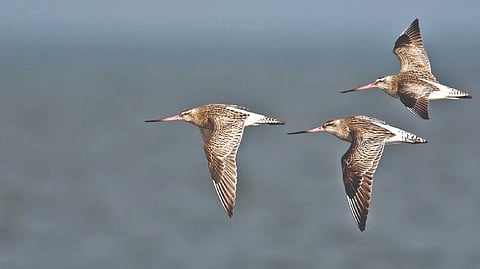

NEW YORK: Tens of thousands of bar-tailed godwits are taking advantage of favourable winds this month and next for their annual migration from the mud flats and muskeg of southern Alaska, south across the vast expanse of the Pacific Ocean, to the beaches of New Zealand and eastern Australia. They are making their journey of more than 7,000 miles by flapping night and day, without stopping to eat, drink or rest.
“The more I learn, the more amazing I find them,” said Theunis Piersma, a professor of global flyway ecology at the University of Groningen in the Netherlands and an expert in the endurance physiology of migratory birds. “They are a total evolutionary success.”
The godwit’s epic flight — the longest non-stop migration of a land bird in the world — lasts from eight to 10 days and nights through pounding rain, high winds and other perils. It is so extreme, and so far beyond what researchers knew about long-distance bird migration, that it has required new investigations.
In a recent paper, a group of researchers said the arduous journeys challenge “underlying assumptions of bird physiology, orientation, and behavior,” and listed 11 questions posed by such migrations. Dr. Piersma called the pursuit of answers to these questions “the new ornithology.”
The extraordinary nature of what bar-tailed and other migrating birds accomplish has been revealed in the last 15 years or so with improvements to tracking technology, which has given researchers the ability to follow individual birds in real time and in a detailed way along the full length of their journey. “You know where a bird is almost to the meter, you know how high it is, you know what it’s doing, you know its wing-beat frequency,” Dr. Piersma said. “It’s opened a whole new world.”
(Sea-faring Polynesian cultures, the scientists wrote in the paper, knew about the migrations long ago and used the birds to assist in navigation.)
The known distance record for a godwit migration is 13,000 kilometers, or nearly 8,080 miles. It was set last year by an adult male bar-tailed godwit with a tag code of 4BBRW that encountered inclement weather on his way to New Zealand and veered off course to a more distant landing in Australia. He had flapped his wings for 237 hours without stopping when he touched down. (In the last week, he has left Alaska again and is en route to his southern destination.) Other birds do stay aloft for long periods using a technique called “dynamic soaring,” while godwits power themselves by continuous flapping, which takes far more energy.
The globe-trotting birds are in search of an endless summer, and some 90,000 or so depart Alaska from the Yukon-Kuskokwim Delta and environs, where they breed and raise their young. Both Alaska and New Zealand are rich in foods that godwits like, especially the insects in Alaska for newly hatched chicks. And New Zealand has no predatory falcons, while Alaska offers secure habitat. Once they reach New Zealand and the austral summer, the sleek birds — with mottled brown-and-white aerodynamic wings; cinnamon-colored breasts; long, slender beaks; and stilt-like legs — feed on glistening mud flats until March, when they begin their journey back north.
Visit news.dtnext.in to explore our interactive epaper!
Download the DT Next app for more exciting features!
Click here for iOS
Click here for Android